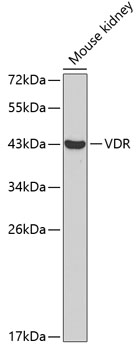Anti-VDR Antibody (CAB2194)
- SKU:
- CAB2194
- Product type:
- Antibody
- Reactivity:
- Human
- Reactivity:
- Mouse
- Reactivity:
- Rat
- Host Species:
- Rabbit
- Isotype:
- IgG
- Research Area:
- Epigenetics and Nuclear Signaling
Description
| 抗体名: | Anti-VDR Antibody |
| 抗体コード: | CAB2194 |
| 抗体サイズ: | 20uL, 50uL, 100uL |
| 申し込み: | WB IHC IF |
| 反応性: | Human, Mouse, Rat |
| 宿主種: | Rabbit |
| 免疫原: | Recombinant fusion protein containing a sequence corresponding to amino acids 1-300 of human VDR (NP_000367.1). |
| 申し込み: | WB IHC IF |
| 推奨希釈: | WB 1:500 - 1:2000 IHC 1:50 - 1:200 IF 1:50 - 1:100 |
| 反応性: | Human, Mouse, Rat |
| ポジティブサンプル: | Mouse kidney |
| 免疫原: | Recombinant fusion protein containing a sequence corresponding to amino acids 1-300 of human VDR (NP_000367.1). |
| 精製方法: | Affinity purification |
| ストレージバッファ: | Store at -20'C. Avoid freeze / thaw cycles. Buffer: PBS with 0.02% sodium azide, 50% glycerol, pH7.3. |
| アイソタイプ: | IgG |
| 順序: | MEAM AAST SLPD PGDF DRNV PRIC GVCG DRAT GFHF NAMT CEGC KGFF RRSM KRKA LFTC PFNG DCRI TKDN RRHC QACR LKRC VDIG MMKE FILT DEEV QRKR EMIL KRKE EEAL KDSL RPKL SEEQ QRII AILL DAHH KTYD PTYS DFCQ FRPP VRVN DGGG SHPS RPNS RHTP SFSG DSSS SCSD HCIT SSDM MDSS SFSN LDLS EEDS DDPS VTLE LSQL SMLP HLAD LVSY SIQK VIGF AKMI PGFR DLTS EDQI VLLK SSAI EVIM LRSN ESFT MDDM SWTC GNQD YKYR VSDV |
| 遺伝子ID: | 7421 |
| Uniprot: | P11473 |
| セルラーロケーション: | Nucleus |
| 計算された分子量: | 48kDa/53kDa |
| 観察された分子量: | 43kDa |
| 同義語: | VDR, NR1I1, PPP1R163 |
| バックグラウンド: | This gene encodes the nuclear hormone receptor for vitamin D3. This receptor also functions as a receptor for the secondary bile acid lithocholic acid. The receptor belongs to the family of trans-acting transcriptional regulatory factors and shows sequence similarity to the steroid and thyroid hormone receptors. Downstream targets of this nuclear hormone receptor are principally involved in mineral metabolism though the receptor regulates a variety of other metabolic pathways, such as those involved in the immune response and cancer. Mutations in this gene are associated with type II vitamin D-resistant rickets. A single nucleotide polymorphism in the initiation codon results in an alternate translation start site three codons downstream. Alternative splicing results in multiple transcript variants encoding different proteins. |
| UniProt Protein Function: | VDR: Nuclear hormone receptor. Transcription factor that mediates the action of vitamin D3 by controlling the expression of hormone sensitive genes. Regulates transcription of hormone sensitive genes via its association with the WINAC complex, a chromatin-remodeling complex. Recruited to promoters via its interaction with the WINAC complex subunit BAZ1B/WSTF, which mediates the interaction with acetylated histones, an essential step for VDR-promoter association. Plays a central role in calcium homeostasis. Defects in VDR are the cause of rickets vitamin D- dependent type 2A (VDDR2A). A disorder of vitamin D metabolism resulting in severe rickets, hypocalcemia and secondary hyperparathyroidism. Most patients have total alopecia in addition to rickets. Belongs to the nuclear hormone receptor family. NR1 subfamily. |
| UniProt Protein Details: | Protein type:DNA-binding; Transcription factor; Nuclear receptor Chromosomal Location of Human Ortholog: 12q13.11 Cellular Component: nucleoplasm; nucleus; receptor complex Molecular Function:retinoid X receptor binding; protein binding; DNA binding; zinc ion binding; sequence-specific DNA binding; steroid hormone receptor activity; vitamin D3 receptor activity; transcription factor activity Biological Process: lactation; transcription initiation from RNA polymerase II promoter; positive regulation of apoptosis involved in mammary gland involution; cell morphogenesis; decidualization; negative regulation of transcription from RNA polymerase II promoter; signal transduction; intestinal absorption; cellular calcium ion homeostasis; negative regulation of cell proliferation; calcium ion transport; steroid hormone mediated signaling; positive regulation of transcription from RNA polymerase II promoter; gene expression; negative regulation of transcription, DNA-dependent; skeletal development; positive regulation of keratinocyte differentiation Disease: Vitamin D-dependent Rickets, Type 2a; Osteoporosis |
| NCBI Summary: | This gene encodes the nuclear hormone receptor for vitamin D3. This receptor also functions as a receptor for the secondary bile acid lithocholic acid. The receptor belongs to the family of trans-acting transcriptional regulatory factors and shows sequence similarity to the steroid and thyroid hormone receptors. Downstream targets of this nuclear hormone receptor are principally involved in mineral metabolism though the receptor regulates a variety of other metabolic pathways, such as those involved in the immune response and cancer. Mutations in this gene are associated with type II vitamin D-resistant rickets. A single nucleotide polymorphism in the initiation codon results in an alternate translation start site three codons downstream. Alternative splicing results in multiple transcript variants encoding different proteins. [provided by RefSeq, Feb 2011] |
| UniProt Code: | P11473 |
| NCBI GenInfo Identifier: | 137617 |
| NCBI Gene ID: | 7421 |
| NCBI Accession: | P11473.1 |
| UniProt Secondary Accession: | P11473,Q5PSV3, B2R5Q1, G3V1V9, |
| UniProt Related Accession: | P11473 |
| Molecular Weight: | |
| NCBI Full Name: | Vitamin D3 receptor |
| NCBI Synonym Full Names: | vitamin D (1,25- dihydroxyvitamin D3) receptor |
| NCBI Official Symbol: | VDR |
| NCBI Official Synonym Symbols: | NR1I1; PPP1R163 |
| NCBI Protein Information: | vitamin D3 receptor; 1,25-dihydroxyvitamin D3 receptor; vitamin D nuclear receptor variant 1; nuclear receptor subfamily 1 group I member 1; protein phosphatase 1, regulatory subunit 163 |
| UniProt Protein Name: | Vitamin D3 receptor |
| UniProt Synonym Protein Names: | 1,25-dihydroxyvitamin D3 receptor; Nuclear receptor subfamily 1 group I member 1 |
| Protein Family: | Vitamin D3 receptor |
| UniProt Gene Name: | VDR |
| UniProt Entry Name: | VDR_HUMAN |


